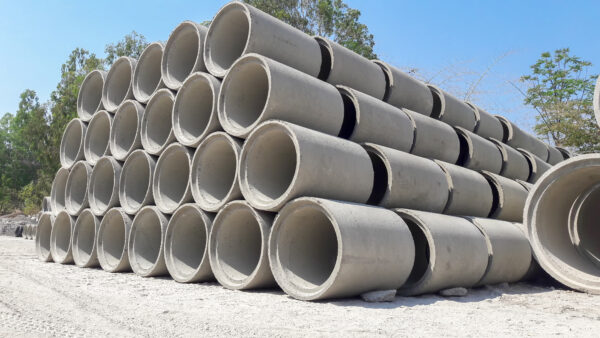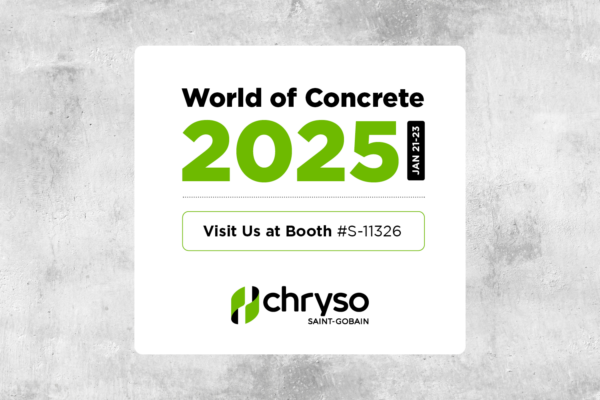Proportioning DCI® (and DCI® S) Concrete Mixes – TB-0900

This technical bulletin includes mix design guidelines for concrete containing DCI® Corrosion Inhibitor. The information should be helpful when preparing for DCI® concrete projects and making adjustments during construction.
A Special Note Regarding DCI® S and Retarders as They Relate to this Technical Bulletin
DCI® S is a corrosion inhibitor which is formulated for concreting situations where accelerated concrete set times are not required or desired. DCI® S contains ingredients which provide it with essentially neutral setting characteristics. The dosage rate of DCI® S is identical to DCI®. The information in this technical bulletin applies equally to both products with the exception that DCI® S will require much less retarding admixture to offset acceleration. This should be considered when using this technical bulletin to design concrete mixes containing DCI® S.
Pre-Bid Information
Basic to planning any DCI® concrete job are the project specifications and the construction requirements. Once these factors are established, a concrete mix should be designed and a test program initiated. Typical specifications for a DCI® project include the following:
- Maximum water/cement ratio 0.40
- Air content 7% + 1%
- DCI® dosage rate 10 to 30 L/m3 (2 to 6 gal/yd3)
- Compressive strength at 28 days 31 MPa (4500 psi)
Construction requirements include:
- Slump and slump life
- Travel time to job site
- Early strength requirements (if any)
- Strength required at 28 days
- Methods of placing, finishing and curing
- Set time desired
- Expected weather conditions (temperature, humidity, wind, etc.)
Testing Program
Test the concrete before bidding when possible and always test before actual construction starts. Critical design factors to consider during testing include:
- Water requirement
- Cement content
- Superplasticizer dosage rate
- Retarder or water reducer dosage rate
- Air-entraining agent dosage rate
Water and Cement Requirements
Table 1 gives typical water contents and slumps for various water/cement ratios without adding water reducers. Testing is needed to determine the actual water required for any given set of materials.
Table 1: Cement and Water Required for Slump with DCI® Corrosion Inhibitor
| SI Units below, US units to right | ||||||||
| W/C | Cement, kg/m3 | Water, kg/m3 | Slump, mm | Slump, with 20 L/m3 DCI®* | Cement lbs/yd3 | Water lbs/yd3 | Slump, in. | Slump, in. with 4.0 gal/yd3 DCI®* |
| 0.40 | 356 | 142 | – | – | 600 | 240 | – | – |
| 0.40 | 371 | 148 | – | – | 625 | 250 | – | – |
| 0.40 | 386 | 154 | 25 | 25 | 650 | 260 | 1.0 | 1.0 |
| 0.40 | 400 | 160 | 51 | 38 | 675 | 270 | 2.0 | 1.5 |
| 0.40 | 415 | 166 | 76 | 64 | 700 | 280 | 3.0 | 2.5 |
| 0.40 | 445 | 178 | 102 | 76 | 750 | 300 | 4.0 | 3.0 |
| 0.40 | 460 | 184 | 127 | 102 | 775 | 310 | 5.0 | 4.0 |
| 0.45 | 356 | 160 | 51 | 38 | 600 | 270 | 2.0 | 1.5 |
| 0.45 | 386 | 174 | 89 | 64 | 650 | 292 | 3.5 | 2.5 |
| 0.45 | 395 | 178 | 102 | 76 | 665 | 300 | 4.0 | 3.0 |
| 0.45 | 415 | 187 | 140 | 102 | 700 | 315 | 5.5 | 4.0 |
As can be seen, the addition of DCI® has a negative effect on slump when the water/cement ratio is kept constant. Therefore, a water reducer is needed when designing a DCI® concrete mix. After determining the slump required to place the concrete, simply read across to the corresponding water and cement contents. Adjust these amounts to accommodate high-range water reducers (HRWR), fly ash, slag and other admixtures (see example below). Test the mix to determine actual slump. Use a high-range water reducer such as ADVA® or a DARACEM® family product to increase slump and workability in low water/cement ratio concrete.
Set Acceleration
(see note above regarding DCI® S)
DCI® will accelerate initial set and strength development. Normal or delayed set may be achieved by incorporating water-reducing retarders. Table 2 shows typical dosage rates of DARATARD®17 for normal set at 50°, 70° and 90°F. The actual dosage rate will vary with location and weather conditions.
Mix Water Compensation for Water in DCI® (DCI® S)
Mix water reduction at the batch plant is essential to compensate for the water content of DCI® and to maintain the specified water/cement ratio. The water reduction factor for both DCI® and DCI® S is 0.86 kg/L (7.0 lbs/gal) of DCI® admixture added to the mix. Example: 19.8 L/m3 (4.0 gal/yd3) of DCI® is added to a mix containing 163 kg/m3 (275 lbs/yd3) of water.
Reduce the water added to the mix as follows:
- SI: 19.8 L/m3 x 0.86 kg/L = 17.0 kg/m3 water added to the mix by DCI®
- Water adjustment: 163 kg/m3 – 17.0 kg/m3 = 146 kg/m3 water added to the mix
- US: 4.0 gal/yd3 x 7.0 lbs/gal = 28 lbs/m3 water added to the mix by DCI®
- Water adjustment: 275 lbs/yd3 – 28 lbs/yd3 = 247 lbs/yd3 water added to the mix
DCI® Test Program
Using the cement content from Table 1 and the retarder dosage rate from Table 2, DCI® concrete should be adjusted for slump and air content using a high-range water reducer and an air-entraining agent as required. The mix should be tested to verify performance. The sequence of batching the mix materials is critical. It is generally more convenient to batch all the materials, including DCI® at the plant. DCI® may be added to the plant water discharge line after most material has been batched into the central mixer or truck but before the “tail-end” water, the air-entraining agent should be added with the fine aggregate, and the retarder should be added separately. If job site addition of DCI® is required, the batching sequence must be altered accordingly. Usually, the air-entraining agent, retarder and often the high-range water reducer are added at the batch plant, with the DCI® added at the job site.
Table 2: Retarder Dosage (DARATARD® 17) Needed to Provide Neutral Set With DCI® at Various Dosages
| Temperature | 10°C (50°F) | 21°C (70°F) | 32°C (90°F) |
| DCI® dosage rate | DARATARD® 17 Dosage, mL/100 kg (oz/100 lbs) of Cement | ||
| 15–20 L/m3 (3.0–4.0 gal/yd3) | 130 (2) | 261 (4) | 326 (5) |
| 20–27 L/m3 (4.0–5.5 gal/yd3) | 196 (3) | 326 (5) | 456 (7) |
| 27–30 L/m3 (5.5–6.0 gal/yd3) | 261 (4) | 391 (6) | 522 (8) |
During testing, actual job conditions should be simulated as nearly as possible. The conditions tested should include:
- Actual production procedures
- Actual travel time to job site
- Actual slump, air, set time required
- Actual ambient temperature and project conditions
Seven Steps to a DCI® Concrete Mix Design (an Example)
Step 1: Project Specifications
Gather all information regarding the project specification and special construction requirements.
| Maximum W/C ratio | 0.40 |
| Air content | 7% ± 1% |
| Compressive strength at 28 days | 31 MPa (4500 psi) |
| Slump | 102 mm ± 25 mm (4 in. ± 1 in.) |
| DCI® dosage rate | 19.8 L/m3 (4.0 gal/yd3) |
| Estimated ambient temperature | 21°C (70°F) |
Step 2: Start with a Workable Mix
A cement content of 335 kg/m3 (564 lbs/yd3) would produce 31 MPa (4500 psi) in 28 days at a water/cement ratio of 0.40; however, the mix would be very stiff and unworkable even with a high-range water reducer, due to the water content of 134 kg/m3 (226 lbs/yd3) at 0.40 water/cement ratio. Start with the 102 mm (4 in.) slump required at the job site. From Table 1, at 102 mm (4 in.) slump, 20 L/m3 (4 gal/yd3) of DCI® and no other admixtures would require 460 kg/m3 (775 lbs/yd3) of cement and 184 kg/m3 (310 lbs/yd3) of water.
Step 3: Offsetting DCI®’s Set Acceleration with Retarder (See Earlier Note Regarding DCI® S)
Using Table 2, at an ambient temperature of 21°C (70°F), 261 mL/100 kg (4 oz/100 lbs) of DARATARD® 17 is required to offset the accelerating action of DCI®.
Step 4: Air Entrainment
7% + 1% air content DAREX® or DARAVAIR® dosed as needed.
Step 5: Water Reduction
Incorporating 228 mL/100 kg (3.5 oz/100 lbs) of ADVA® plus DARATARD® 17 at 261 mL/100 kg (4 oz/100 lbs) allows a 15% water reduction. The following calculations will determine the adjusted cement and water contents:
- Water required: From Table 1, 184 kg/m3 (310 lbs/yd3) of water are required to provide a 102 mm (4 in.) slump with 460 kg/m3 (775 lbs/yd3) cement and 19.8 L/m3 (4.0 gal/yd3) of DCI®. ADVA® and DARATARD® 17 can provide a 15% water reduction.
SI: 184 kg x 15% = 28 kg of water; 184 kg – 28 kg = 156 kg/m3 water required
US: 310 lbs x 5% = 47 lbs of water; 310 lbs – 47 lbs = 263 lbs/yd3 water required - Cement adjustment: The reduction of water allows for a reduction of cement as long as the specified water/cement ratio of 0.40 is not exceeded
SI: 156 kg/m3 / 0.40 = 390 kg/m3 cement required
US: 263 lbs/yd3 / 0.40 = 658 lbs/yd3 cement required
Step 6: DCI® Water Compensation
Mix water must be reduced to compensate for the water contained in DCI®.
SI: 19.8 L/m3 x 0.86 kg/L = 17 kg/m3 water added by DCI®; 156 kg/m3 – 17 kg/m3 = 139 kg/m3 water required
US: 4.0 gal/yd3 x 7.0 lbs/gal = 28 lbs/yd3 water added by DCI®; 263 lbs/yd3 – 28 lbs/yd3 = 235 lbs/yd3 water required
Step 7: Test the Mix for Performance and Make Adjustments as Needed Prior to Construction
| Materials | Mass/m3 | Weight/yd3 |
| Cement | 390 kg | 658 lbs |
| Water | 156 kg | 235 lbs |
| DCI® | 19.8 L | 4.0 gal |
| ADVA® | 228 mL/100 kg | 3.5 oz/100 lbs |
| DARATARD® 17 | 261 mL/100 kg | 4.0 oz/100 lbs |
| DAREX® or DARAVAIR® | as needed | as needed |





